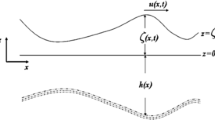Abstract
The software System for Simulation Modeling of Water Bodies, which was developed at the V. M. Glushkov Institute of Cybernetics of NASU, includes the subsystems for modeling changes in the oxygen mode and pollution transport by watercourses, filtration processes in underground water-bearing horizons, flow states in water reservoirs, and an intelligent method for processing, compressing, and recovering arrays of numeric data with a guaranteed accuracy using the apparatus of the best Chebyshev approximation applied in all the subsystems. Models for some water bodies of Ukraine are created for the first time. The System is extensible, i.e., is open to include new models and objects. The subsystem of modeling water flows in water bodies is described in more detail.
Similar content being viewed by others
References
A. O. Kalenchuk-Porkhanova, “System for modeling the state of water bodies of the Northwest Black Sea,” in: Proc. 2nd Congress of the Hydrobiological Society of Ukraine, Vol. 2, Kyiv (1997), 207–208.
V. I. Lavrik and A. A. Kalenchuk-Porkhanova, “A system for simulation modeling of the ecological state of river mouths, estuaries, and lakes of the North-Western Black Sea region,” in: Proc. Sci. Conf. “Diagnosis of the state of the Black Sea ecosystem and the land and sea interface zone,” Sevastopol (1997), pp. 88–89.
N. V. Basok, M. A. Khybyna, V. Ya. Khilchenko, and L. M. Yurachkivska, “System for modeling the state of water bodies,” in: Technical and System Environmental Monitoring Means, V. M. Glushkov Institute of Cybernetics of NAS of Ukraine, Kyiv (1998), pp. 46–51.
A. A. Kalenchuk-Porkhanova, “Approximation of functions of one and many variables,” in: Numerical Methods for the Multiprocessor Computer Complex ES [in Russian], Izd. VVIA im. N. E. Zhukovskogo (1987), pp. 366–395.
A. A. Kalenchuk-Porkhanova and L. P. Vakal, “On a method for transforming environmental information,” in: Hardware and Software Means of Environmental Monitoring Systems, V. M. Glushkov Institute of Cybernetics of NAS of Ukraine, Kyiv (1994), pp. 76–80.
A. A. Kalenchuk-Porkhanova, “Approximation apparatus for analysis and synthesis of complex systems,” in: Proc. Conf. “50 years to the V. M. Glushkov Institute of Cybernetics of NASU,” Kyiv (2008), pp. 354–361.
A. A. Kalenchuk-Porkhanova and L. P. Vakal, “Approximation apparatus of the software of a supercomputer with cluster architecture,” Artificial Intelligence, No. 1, 158–165 (2009).
A. A. Kalenchuk-Porkhanova, “Best Chebyshev approximation of functions of one and many variables,” Cybernetics and Systems Analysis, Vol. 45, No. 6, 988–996 (2009).
A. A. Kalenchuk-Porkhanova, “Methods for increasing the efficiency of computations using the apparatus of the best Chebyshev approximation,” in: Proc. Conf. “High performance computing (HPC-UA 2012),” Kyiv (2012), pp. 195–202.
L. P. Vakal, “Using genetic algorithm for solving boundary value problems,” Journal of Automation and Information Sciences, Vol. 47, No. 8, 52–62 (2015).
A. G. Ivakhnenko and V. S. Stepashko, Noise Immunity of Modeling [in Russian], Naukova Dumka, Kiev (1985).
A. A. Kalenchuk-Porhanova and N. V. Basok, “Subsystem to simulate changes of the oxygen regime in waterways,” Computer Mathematics, Iss. 1, 18–25 (2015).
A. A. Kalenchuk-Porkhanova, “Mathematical modelling of the transfer pollutions in the water-ways,” Computer Means, Networks and Systems, No. 14, 16–25 (2015).
A. A. Kalenchuk-Porkhanova and N. V. Basok, “Simulating processes in underground aquifers,” Computer Mathematics, Iss. 2, 139–149 (2015).
A. I. Felzenbaum, Theoretical Fundamentals and Methods of Calculating a Steady Sea Current [in Russian], Izd. AN SSSR, Moscow (1960).
L. P. Vakal, “Seeking optimal knots for segment approximation,” Journal of Automation and Information Sciences, Vol. 48, No. 11, 68–75 (2016).
L. P. Vakal, A. A. Kalenchuk-Porkhanova, and E. S. Vakal, “Increasing the efficiency of Chebyshev segment fractional rational approximation,” Cybernetics and Systems Analysis, Vol. 53, No. 5, 759–765 (2017).
Author information
Authors and Affiliations
Corresponding author
Additional information
Translated from Kibernetika i Sistemnyi Analiz, No. 4, July–August, 2019, pp. 184–193.
Rights and permissions
About this article
Cite this article
Kalenchuk-Porkhanova, A.A. Modeling Flow States in Water Bodies. Cybern Syst Anal 55, 683–691 (2019). https://doi.org/10.1007/s10559-019-00178-9
Received:
Published:
Issue Date:
DOI: https://doi.org/10.1007/s10559-019-00178-9




